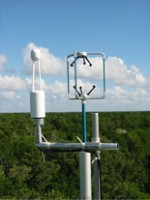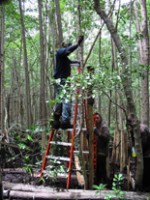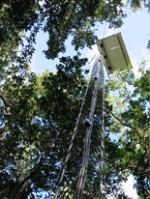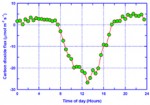Throughout the world, scientists are studying the ability of the biosphere to sequester carbon because of the climatic impacts of increasing ambient carbon dioxide (CO2) levels. The resulting knowledge is utilized to constrain levels of atmospheric carbon dioxide. One biome that has yet to be investigated for its carbon uptake capabilities is the mangrove forests.
Mangrove ecosystems represent a potentially significant carbon sink because of year-round physiologically active foliage, as well as carbon exchanges at the estuary interface and continuous accretion of sediments.
During June 2003, a 30-m tall triangular tower was erected in a riverine mangrove forest (Figure 1) to use as a platform to deploy flux measurement systems. The study site is located along the Shark River in the western region of the Florida Everglades, and is adjacent to the Florida Coastal Everglades Long-Term Ecological Research (FCE-LTER) site SRS-6 (Figure 2). The dominant tree species around the tower include red (Rhizophora mangle), black (Avicennia germinans), and white (Languncularia lacemosa) mangroves. The average tree height for this forest canopy is 15 m but trees as high as 25 m can be found randomly scattered throughout the landscape. The tower flux site is reached via a 30-km boat ride from the Flamingo ranger station in the Everglades National Park. A raised 200-meterlong boardwalk was installed to provide tower access from the shore. This is essential because the sediment floods with 0.5 m of water during high tides. The boardwalk also protects prop roots, seedlings, and the sediment from repeated disturbances.
The tower (Figure 3) is currently instrumented to define the micrometeorological conditions inside and just above the canopy, and to study mangrove physiology. Current measurement and data acquisition systems are powered with a combination of solar panels and batteries.
Continuous field measurements from an eddy covariance (EC) system provide the net exchange of carbon dioxide across the forest-atmosphere interface every half hour. The EC system consists of a three-dimensional sonic anemometer and a fast response open-path gas analyzer (Figure 1).
When measured over days and weeks, these measurements provide the magnitude of the net carbon exchange between atmosphere and forest, sediment accretion, and estuary exchange. Several key local climate New Flux Tower Facility at FCE LTER variables are also continuously measured from the tower. These variables control carbon sequestration on short (half-hour) time scales, and are being used in a coupled forest atmosphere biophysical exchange model to predict forest productivity.
Additional tower instruments include radiometers to measure light levels, anemometers to measure atmospheric turbulence, air thermometers, hygristors to measure humidity, and soil thermometers. These measurements, combined with tidal and salinity information, elucidate the response of the mangrove biome to climate change (e.g. sea level rise) and changes in the quantity and quality of freshwater flow from the greater Everglades.
The CO2 fluxes to the mangrove forest show strong diurnal variations and unusually high values, with maximum daytime fluxes reaching -30 micro-moles (CO2) m-2 (ground area) s-1 (Figure 4). Photosynthetically active irradiance (PAR) and temperature (Figure 5) principally and strongly modulate the diurnal patterns of CO2 fluxes. Atmospheric turbulence also exerts a great influence on the magnitude of CO2 fluxes. The observed patterns and magnitude of CO2 fluxes (Figure 5) support the hypothesis that mangrove forests constitute an important carbon sink.

 Enlarge this image
Enlarge this image



![Figure 5. Time series for air temperature ([]) and photosynthetically active irr](sites/news.lternet.edu/files/imagecache/thumbnail_image/images/node526img495.jpg)